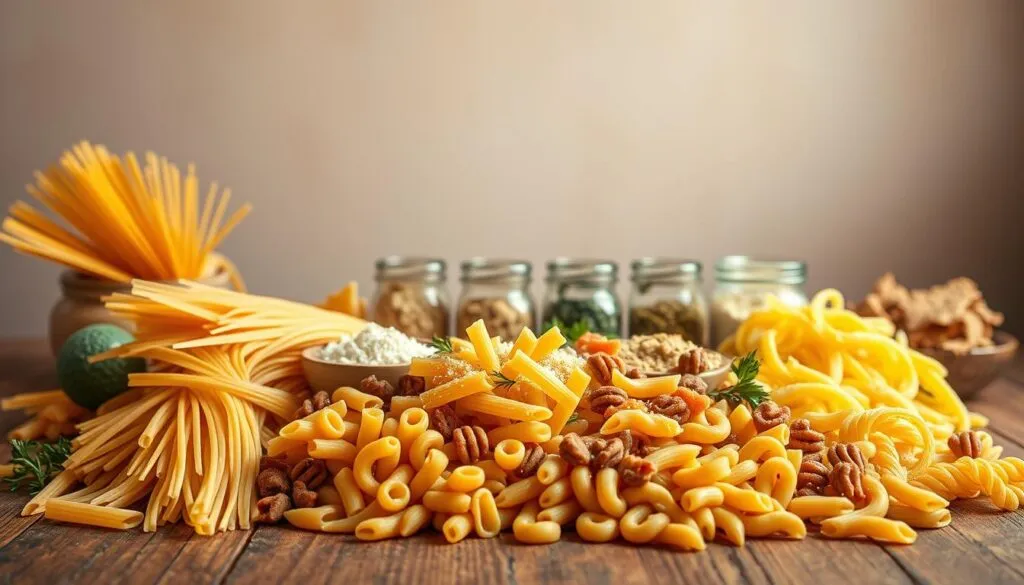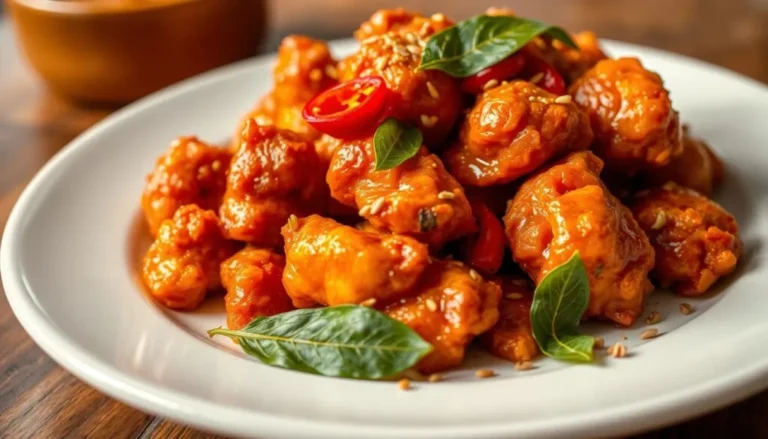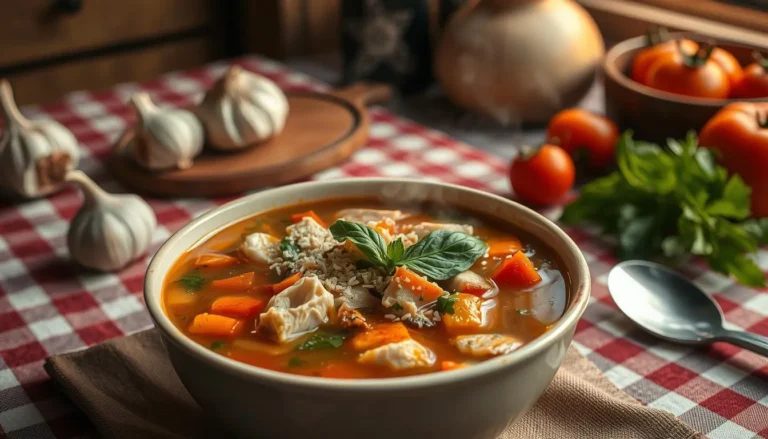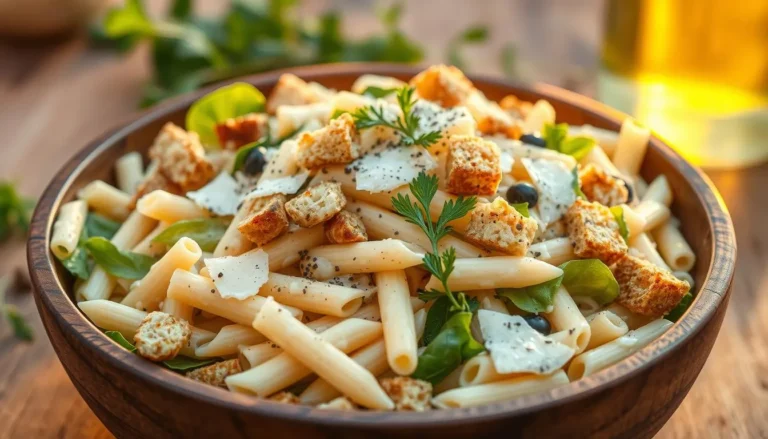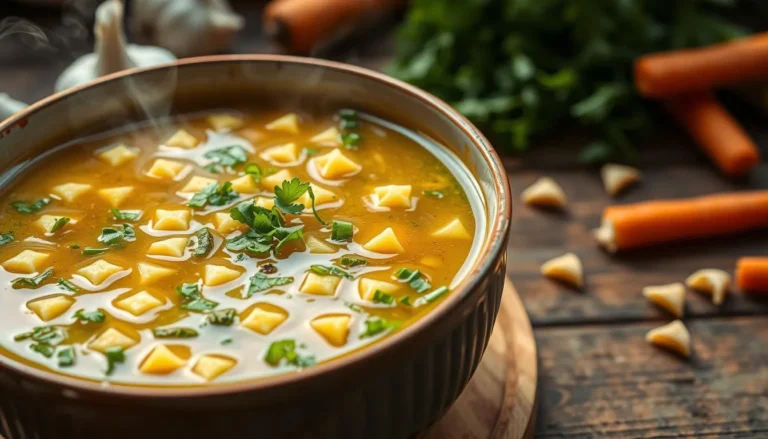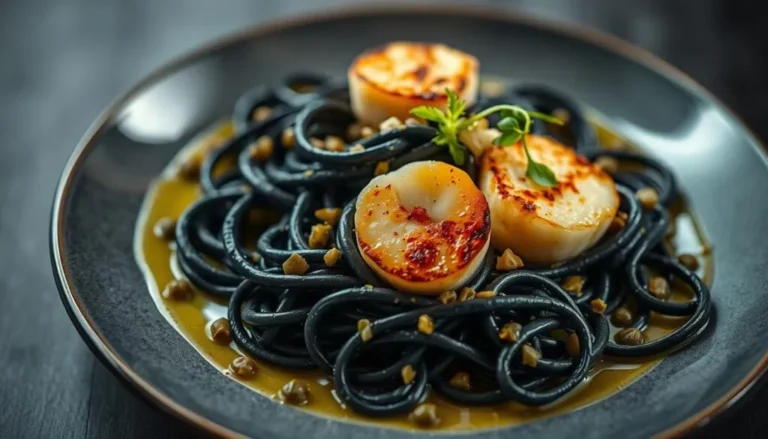Pasta Noodles : How to Cook Them Perfectly Every Time
Table of Contents
Every home cook dreams of making pasta noodles as good as those in restaurants. Growing up, I saw food as an art form. Cooking pasta is more than boiling water; it’s about technique, timing, and passion.
Pasta noodles might seem simple, but mastering them takes skill and knowledge. Whether it’s spaghetti for dinner or a special Italian feast, the right techniques make all the difference. They turn an ordinary meal into a special experience.
This guide will teach you how to cook perfect pasta noodles every time. You’ll learn professional techniques to improve your Italian cooking. These skills will impress everyone at your table.
Key Takeaways
- Choose the right pot size for optimal pasta cooking
- Understand the importance of salt and water ratio
- Learn precise cooking times for different pasta types
- Master the art of achieving al dente texture
- Avoid common pasta cooking mistakes
Understanding the Basics of Italian Pasta
Pasta is a culinary art form deeply rooted in Italian tradition. Your journey into the world of pasta begins with understanding its fundamental components and varieties. From the rolling hills of Italy to kitchens worldwide, pasta represents more than just a meal – it’s a cultural experience.
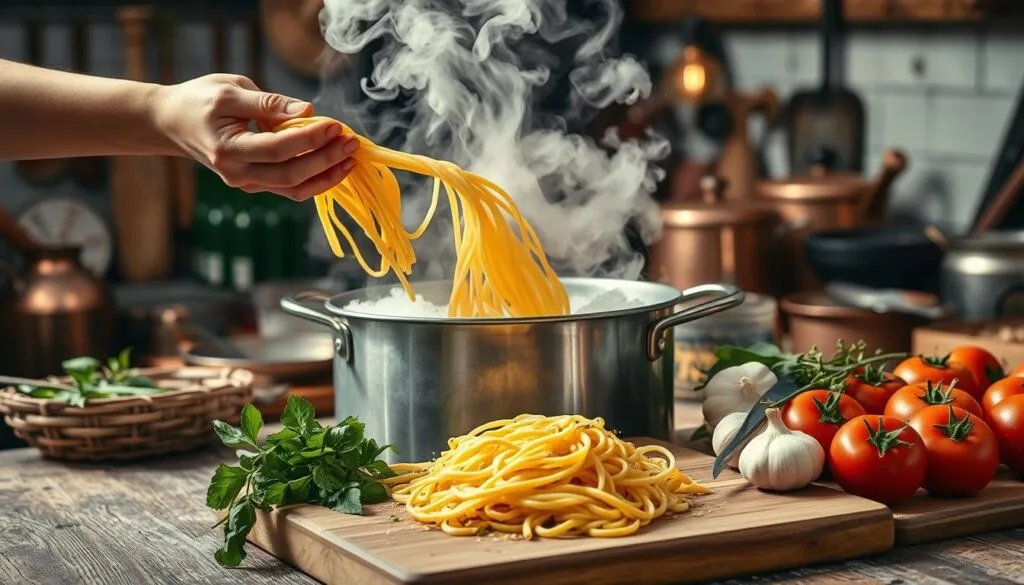
Most commercial dried pasta starts with durum wheat, a hard wheat variety prized for its high protein content and gluten strength. Semolina flour, ground from durum wheat, forms the backbone of authentic pasta production. This special flour gives pasta its distinctive texture and ability to hold sauce perfectly.
Types of Dried Pasta
Italian pasta comes in an incredible array of shapes, each designed for specific culinary purposes. Some popular varieties include:
- Penne: Tubular pasta with ridged surfaces
- Farfalle: Butterfly-shaped pasta perfect for light sauces
- Rigatoni: Wide tubes ideal for hearty meat sauces
- Fusilli: Spiral-shaped pasta that catches sauce beautifully
Fresh vs Dried Pasta Differences
The primary distinction between fresh and dried pasta lies in their ingredients and preparation. Dried pasta typically contains only semolina flour and water, while fresh pasta often incorporates eggs. Fresh pasta cooks faster and has a more delicate texture, making it perfect for lighter dishes.
Essential Pasta Ingredients
Quality pasta relies on three key ingredients: durum wheat, water, and sometimes eggs. The gluten in durum wheat provides the essential protein structure that gives pasta its memorable texture and ability to hold sauce. Bronze-die extruded pasta offers a rougher surface, ensuring better sauce adhesion.
Selecting the Right Equipment for Pasta Cooking
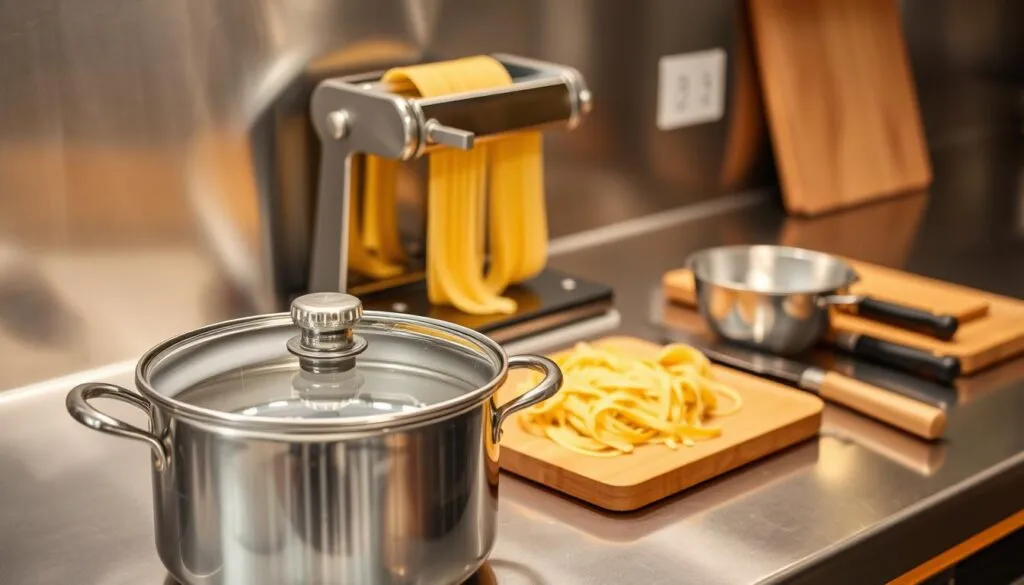
Choosing the right equipment is key to a great pasta cooking experience. You’ll need specific tools for each pasta shape to get perfect results.
Begin with a large, deep pot for different pasta shapes. A 5-6 quart pot is ideal for up to a pound of pasta. This size lets the noodles cook evenly. Avoid using heavy pots like Dutch ovens because they block water flow.
Essential Pasta Cooking Tools
- Large pot with 5-6 quart capacity
- Stainless steel or aluminum pot
- Colander for draining
- Pasta fork or slotted spoon
- Kitchen tongs
When picking pasta equipment, think about these important points:
- Pot material matters – stainless steel and aluminum conduct heat best
- Wide pots prevent pasta shapes from sticking together
- Deep containers allow pasta to move freely while cooking
Professional chefs say quality tools make pasta prep easier. Good tools can take your pasta cooking from okay to amazing.
The right equipment is your secret weapon for perfect pasta every time!
The Science Behind Perfect Pasta Water
Cooking pasta is more than just boiling water and throwing in noodles. It’s about understanding the science behind it. Carbohydrates are key to making the perfect pasta dish. Mastering water preparation is crucial for top-notch results.
Pasta’s chemistry involves water, heat, and carbohydrates. Starch molecules in pasta change a lot during cooking. These changes affect the pasta’s texture and taste.
Water-to-Pasta Ratio Explained
The right water-to-pasta ratio is essential for cooking. Experts suggest:
- Use 4-6 quarts of water for every pound of pasta
- Make sure pasta has enough room to move
- Avoid sticky noodles by preventing starch buildup
Salt Measurements Matter
Salt does more than add flavor. It breaks down starch and improves pasta quality. Here’s the recommended salt ratio:
| Water Volume | Salt Amount |
|---|---|
| 4-6 quarts | 1½ tablespoons |
Temperature Control Techniques
Keeping water at the right temperature is important. Here are some tips:
- Bring water to a rolling boil before adding pasta
- Keep the water hot during cooking
- Stir right after adding pasta to prevent clumping
By understanding these scientific principles, you can take your pasta cooking to the next level. You’ll turn simple carbohydrates into a culinary masterpiece.
Pasta Noodles: Cooking Times and Techniques
Cooking pasta noodles well takes skill and patience. Knowing how long to cook different shapes is key to getting that perfect al dente texture. This is what every home cook aims for.
The cooking time changes a lot based on the pasta type. Thin pasta like angel hair cooks in 3-5 minutes. Thicker pasta, like rigatoni, takes 12-14 minutes.
“The secret to perfect pasta is paying attention during cooking, not just following package instructions.”
Here’s a detailed guide to cooking times for different pasta noodles:
| Pasta Type | Cooking Time |
|---|---|
| Spaghetti | 10-12 minutes |
| Penne | 11-14 minutes |
| Angel Hair | 3-5 minutes |
| Fettuccine | 10-12 minutes |
Important techniques for cooking pasta noodles include:
- Use plenty of salted water
- Stir often to stop sticking
- Check for al dente by tasting
- Save some pasta water for sauce
To get al dente pasta, you need to pay close attention. Start checking your pasta a minute or two before the suggested time. This ensures the perfect texture.
Mastering the Al Dente Texture
Getting the perfect al dente texture is an art. It turns simple pasta into a culinary gem. Learning to cook pasta to the right consistency boosts your cooking skills and wows pasta lovers.
The term al dente means “to the tooth” in Italian. It describes pasta that’s slightly firm when bitten. This texture is key to perfectly cooked pasta, offering a balance of softness and firmness.
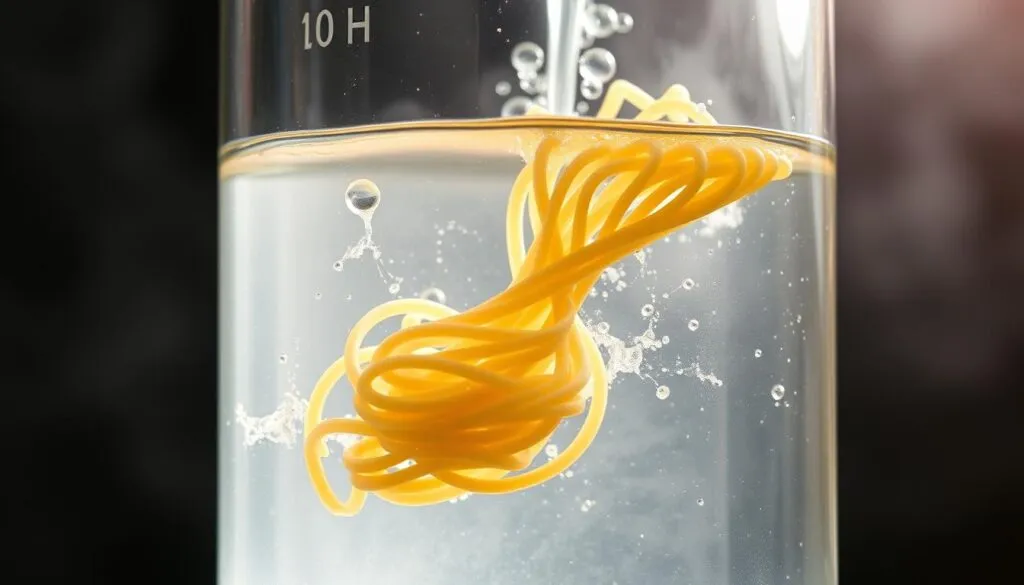
Testing for Doneness
Mastering al dente needs precision and attention. Here are ways to check if your pasta is perfect:
- Bite Test: Remove a piece of pasta and bite into it
- Visual Inspection: Look for a thin white line in the pasta’s cross-section
- Texture Check: Pasta should feel springy and firm
Common Texture Mistakes
Steer clear of these common mistakes when cooking pasta:
- Overcooking, which makes pasta mushy
- Undercooking, leading to hard, raw centers
- Not checking pasta often during cooking
Visual Cues for Perfect Pasta
Different pasta shapes need slight cooking tweaks. Here’s a quick guide for achieving the perfect al dente texture:
| Pasta Shape | Cooking Time | Al Dente Indicator |
|---|---|---|
| Spaghetti | 8-10 minutes | Slight resistance when bitten |
| Penne | 6-8 minutes | White line visible in center |
| Fettuccine | 6-8 minutes | Firm but not crunchy texture |
Pro tip: Start testing your pasta 1-2 minutes before the package’s recommended cooking time to ensure the perfect al dente texture.
Essential Tips for Sauce Integration
Turning your pasta dishes into something special starts with mastering sauce integration. The right sauce techniques can make even simple pasta meals taste like they’re from a restaurant. It’s all about combining pasta and sauce for the best flavor and texture.
When making pasta sauces, keep these key techniques in mind:
- Finish cooking pasta directly in the sauce to help noodles absorb flavors
- Reserve a cup of pasta water to help bind sauce and pasta together
- Add sauce gradually to ensure even coating of noodles
Professional chefs call pasta water liquid gold. It thickens sauces and makes them silky, sticking well to noodles. Just a few tablespoons of pasta water can make a big difference in sauce consistency.
Different pasta sauces need different approaches:
- Cream-based sauces need gentle heating to prevent separation
- Olive oil sauces work best when added immediately after draining pasta
- Tomato sauces benefit from a brief simmer with the pasta
Timing is everything. Add your sauce right after draining pasta for the best flavor and texture. You want every noodle to be perfectly coated, so every bite is delicious.
Common Pasta Cooking Mistakes to Avoid
Cooking perfect pasta noodles in Italian cuisine needs precision and knowledge. Even skilled home cooks can make common mistakes. Knowing these mistakes can improve your pasta-cooking skills.
Oil and Water Myths
One big myth in pasta cooking is adding oil to the water. This doesn’t stop pasta from sticking. Instead, it makes the pasta slippery, so sauce can’t stick to it.
- Avoid adding oil to pasta water
- Let pasta move freely in boiling water
- Stir occasionally to prevent sticking
Rinsing Misconceptions
Rinsing pasta after cooking is a big mistake. The starchy coating on pasta helps sauces stick. Washing away this starch makes pasta less able to blend with sauce.
| Mistake | Consequence | Correct Approach |
|---|---|---|
| Rinsing pasta | Removes essential starch | Reserve pasta water, skip rinsing |
Temperature Control Errors
Getting the water temperature and volume right is key in Italian cooking. Use 4 to 6 quarts of water per pound of pasta. Make sure the water boils well before adding noodles. Salt is key – add 1 tablespoon of kosher salt per quart of water for the best flavor.
Remember, cooking pasta is an art. By avoiding these common mistakes, you’ll make restaurant-quality pasta noodles every time.
Professional Chef Secrets for Restaurant-Quality Pasta
Professional chefs make pasta dishes special with their techniques. They turn simple meals into amazing experiences. Their secrets include precise preparation and blending flavors.
Top chefs share key tips for making pasta like a pro:
- Slightly undercook pasta by about two minutes before finishing in the sauce
- Reserve ½ cup of starchy pasta water for sauce consistency
- Use high-quality ingredients for maximum flavor impact
- Finish cooking pasta directly in the sauce for optimal flavor absorption
Salt is key in making pasta. Chefs use one to two tablespoons of kosher salt per gallon of water. This method seasons pasta from the inside, adding depth to flavors.
Timing is everything in a professional kitchen. They cook pasta and sauce together. This way, both reach their best flavor at the same time. Toss pasta in sauce for 1-2 minutes on low heat for perfect taste and texture.
The art of pasta making is about precision, patience, and passion for Italian cuisine.
By using these pro techniques, you can make your pasta dishes amazing. Enjoy restaurant-quality pasta right in your own kitchen.
Storing and Reheating Cooked Pasta
Keeping your pasta dishes fresh is all about smart storage and reheating. Cooked pasta noodles can stay good in the fridge for 3 to 5 days. This means you can enjoy tasty meals all week long.
To store pasta noodles right, follow these tips:
- Cool pasta quickly after cooking to prevent bacterial growth
- Store in airtight containers with a light drizzle of olive oil
- Separate pasta from sauce before refrigerating
- Use within 3-4 days for best taste and texture
Freezing pasta dishes is also an option. Frozen cooked pasta can be stored for up to 2 months. A helpful tip: Add about 1 tablespoon of oil for every 8 ounces of pasta to stop it from sticking when frozen.
Reheating pasta needs care to keep its texture right. Here are some good ways to do it:
- Boiling water method: Dunk pasta in boiling water for 30-40 seconds
- Skillet technique: Sauté on medium heat for sauced dishes
- Microwave option: Heat in one-minute increments, stirring between intervals
- Oven reheating: Bake at 350°F for approximately 20 minutes
Remember, each time you reheat pasta, it loses a bit of quality. So, reheat only what you’re going to eat. With these tips, you’ll always have tasty pasta noodles ready to go!
Conclusion
Exploring pasta noodles opens the door to Italian cuisine’s rich world. You’ve learned how to turn simple ingredients into amazing meals. Now, you know how to pick the right pasta and cook it perfectly.
Pasta comes in many shapes, like spaghetti and rigatoni, offering endless possibilities. You can now manage moisture, cook pasta just right, and mix sauces well. You can also choose whole wheat or bean-based pasta for healthier meals.
Keep practicing to get better at making pasta. Try different shapes and cooking methods. Italian cooking is all about passion, creativity, and enjoying the cooking process. Your pasta journey is just starting.
With your new skills, you can make pasta dishes that wow everyone. Enjoy the art of pasta cooking and let your creativity shine. Turn simple ingredients into meals that are unforgettable and inspiring.
FAQ
What’s the difference between fresh and dried pasta?
Fresh pasta is made with eggs and flour. It’s softer and cooks fast (2-3 minutes). Dried pasta, made from semolina flour, is firmer and takes longer (8-12 minutes). Fresh pasta is great for delicate dishes, while dried pasta works well with complex sauces.
How much salt should I add to pasta water?
Use 1-2 tablespoons of salt for every pound of pasta. The water should taste like seawater. This seasons the pasta from the inside, making it taste better with sauce.
What does “al dente” mean?
“Al dente” means “to the tooth” in Italian. It’s pasta that’s tender but still firm. This texture is perfect, not too soft or hard.
Should I add oil to my pasta water?
No, don’t add oil to pasta water. Oil stops sauce from sticking to the pasta. Use a large pot with plenty of water and stir to prevent sticking.
How do I prevent pasta from sticking together?
To avoid sticking, use a large pot and plenty of water. Stir often, especially at the start. Don’t rinse pasta after cooking. The starch helps sauce stick.
How long should I cook different pasta shapes?
Cooking times vary by shape and thickness. Thin pasta cooks in 3-4 minutes, while thicker shapes take 10-12 minutes. Always check the package and taste for al dente.
Can I store cooked pasta?
Yes, you can store cooked pasta in an airtight container in the fridge for 3-5 days. When reheating, add a bit of water or sauce to prevent drying. Reheat gently to keep the texture.
What’s the best pot for cooking pasta?
Choose a large, deep stainless steel pot. It should be big enough for plenty of water (about 4-6 quarts for 1 pound of pasta). This ensures even heat and allows pasta to move freely.
Why is pasta water important for sauces?
Pasta water contains starch that thickens and binds sauces. Using reserved pasta water can adjust sauce consistency and make it cling better to noodles.
How can I tell if pasta is cooked correctly?
Use the bite test: cut a piece of pasta and check the center. If it has a small, light core, it’s al dente. The pasta should feel firm but not hard or crunchy.

